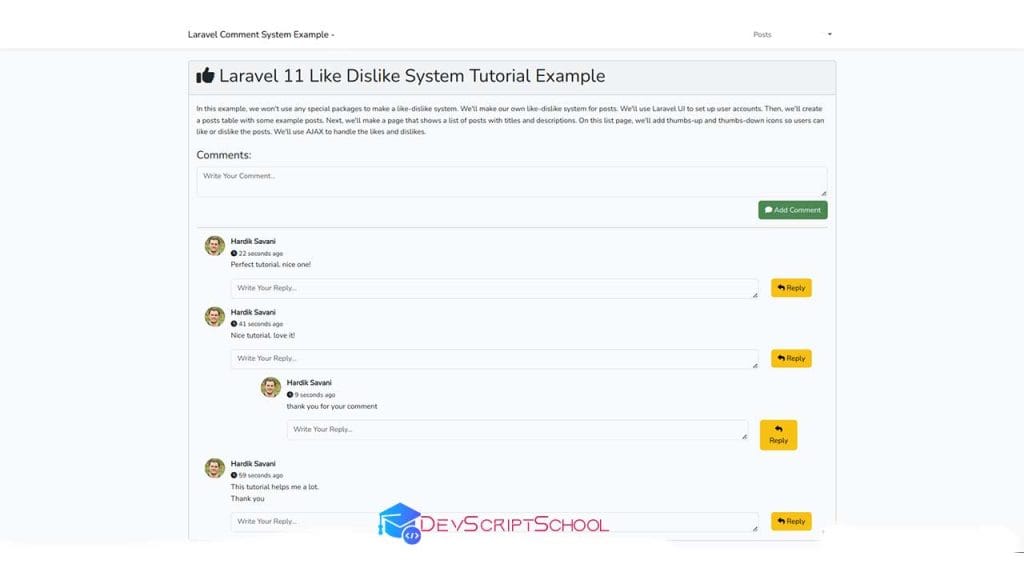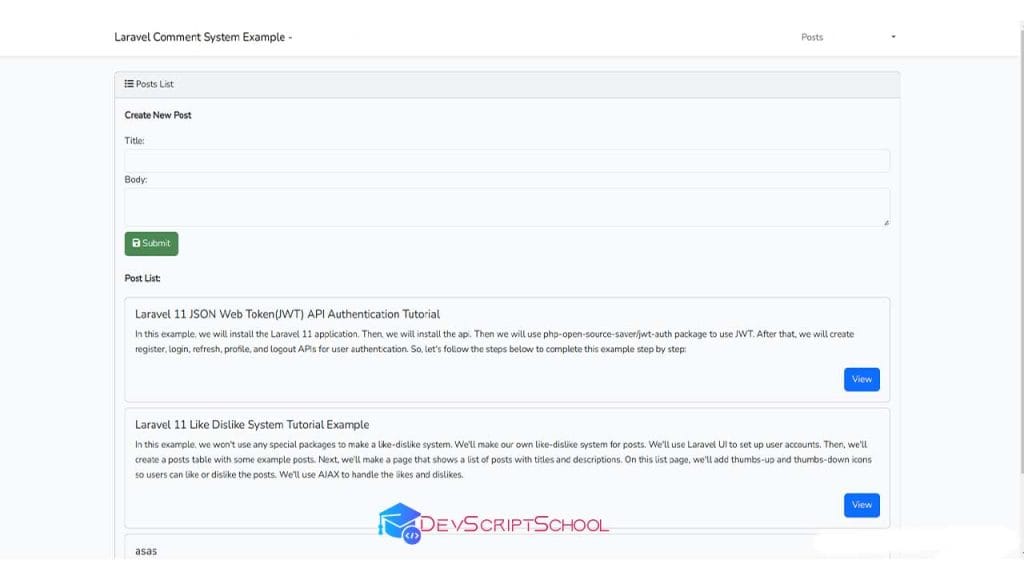In this tutorial, we will learn how to create comment system in laravel 11 application.A Comment system is a primary requirement for blog website or any tutorial website. A comment system on a blog website lets readers share their thoughts, ask questions, and interact with the author and other readers. It builds community, provides valuable feedback, and can increase engagement on the site. Comments make the content more dynamic and engaging, enhancing the reader’s experience and encouraging them to return. They also offer the author insights into their audience’s interests and concerns, helping improve future content. Read Laravel Documentation
In this example, we will install Laravel UI to make a basic login and register system. Then, we will create a table for posts with columns for the title and body. A user can register and make a post. Other users can see the post and add a comment. We will also add a feature so users can reply to comments. We will use Laravel’s relationships to make the comment system work, using hasMany() and belongsTo(). Just follow the steps below to do this example.
You can see the preview of examples:
Post Detail Page:

Post Page:

Step for How to Create Comment System in Laravel 11?
Step 1: Install Laravel 11
This step is not required; however, if you have not created the Laravel app, then you may go ahead and execute the below command:
composer create-project laravel/laravel CommentSystemStep 2: Create Auth using Scaffold
Now, in this step, we will create an auth scaffold command to generate login, register, and dashboard functionalities. So, run the following commands:
Laravel 11 UI Package:
composer require laravel/ui Generate Auth:
php artisan ui bootstrap --auth
npm install
npm run buildStep 3: Create Posts and Comments Tables
Here, we will create posts and comments table. so, let’s run the following command:
php artisan make:migration create_posts_comments_tablenow, let’s update the following migrations:
database/migrations/2024_06_19_140622_create_posts_comments_table.php
<?php
use Illuminate\Database\Migrations\Migration;
use Illuminate\Database\Schema\Blueprint;
use Illuminate\Support\Facades\Schema;
return new class extends Migration
{
/**
* Run the migrations.
*/
public function up(): void
{
Schema::create('posts', function (Blueprint $table) {
$table->id();
$table->string('title');
$table->text('body');
$table->timestamps();
});
Schema::create('comments', function (Blueprint $table) {
$table->id();
$table->integer('user_id')->unsigned();
$table->integer('post_id')->unsigned();
$table->integer('parent_id')->unsigned()->nullable();
$table->text('body');
$table->timestamps();
});
}
/**
* Reverse the migrations.
*/
public function down(): void
{
Schema::dropIfExists('posts');
Schema::dropIfExists('comments');
}
};
now, Let’s run the migration command:
php artisan migrateStep 4: Create Models
Here, we will create Post and Comment model using the following command. we also need to update User model here. we will write relationship and some model function for Comment system.
php artisan make:model Postnow, update the model file with hasMany() relationship:
app/Models/Post.php
<?php
namespace App\Models;
use Illuminate\Database\Eloquent\Factories\HasFactory;
use Illuminate\Database\Eloquent\Model;
class Post extends Model
{
use HasFactory;
/**
* The attributes that are mass assignable.
*
* @var array
*/
protected $fillable = ['title', 'body'];
/**
* The has Many Relationship
*
* @var array
*/
public function comments()
{
return $this->hasMany(Comment::class)->whereNull('parent_id')->latest();
}
}
app/Models/Comment.php
<?php
namespace App\Models;
use Illuminate\Database\Eloquent\Factories\HasFactory;
use Illuminate\Database\Eloquent\Model;
class Comment extends Model
{
use HasFactory;
/**
* The attributes that are mass assignable.
*
* @var array
*/
protected $fillable = ['user_id', 'post_id', 'parent_id', 'body'];
/**
* The belongs to Relationship
*
* @var array
*/
public function user()
{
return $this->belongsTo(User::class);
}
/**
* The has Many Relationship
*
* @var array
*/
public function replies()
{
return $this->hasMany(Comment::class, 'parent_id');
}
}
Step 5: Create Routes
In this step, we need to create some routes for comment system. So open your “routes/web.php” file and add the following route.
routes/web.php
<?php
use Illuminate\Support\Facades\Route;
use App\Http\Controllers\PostController;
Route::get('/', function () {
return view('welcome');
});
Auth::routes();
Route::get('/home', [App\Http\Controllers\HomeController::class, 'index'])->name('home');
Route::middleware('auth')->group(function () {
Route::get('/posts', [PostController::class, 'index'])->name('posts.index');
Route::post('/posts', [PostController::class, 'store'])->name('posts.store');
Route::get('/posts/{id}', [PostController::class, 'show'])->name('posts.show');
Route::post('/posts/comment/store', [PostController::class, 'commentStore'])->name('posts.comment.store');
});
Step 6: Create Controller
Here, we require the creation of a new controller, PostController, with an index method to display comment. So let’s put the code below.
app/Http/Controllers/PostController.php
<?php
namespace App\Http\Controllers;
use Illuminate\Http\Request;
use App\Models\Post;
use App\Models\Comment;
class PostController extends Controller
{
/**
* Display a listing of the resource.
*
* @return \Illuminate\Http\Response
*/
public function index()
{
$posts = Post::latest()->get();
return view('posts.index', compact('posts'));
}
/**
* Write code on Method
*
* @return response()
*/
public function store(Request $request)
{
$this->validate($request, [
'title' => 'required',
'body' => 'required'
]);
$post = Post::create([
'title' => $request->title,
'body' => $request->body
]);
return back()->with('success','Post created successfully.');
}
/**
* Show the form for creating a new resource.
*
* @return \Illuminate\Http\Response
*/
public function show($id)
{
$post = Post::find($id);
return view('posts.show', compact('post'));
}
/**
* Write code on Method
*
* @return response()
*/
public function commentStore(Request $request)
{
$request->validate([
'body'=>'required',
]);
$input = $request->all();
$input['user_id'] = auth()->user()->id;
Comment::create($input);
return back()->with('success','Comment added successfully.');
}
}
Step 7: Create and Update Blade Files
In this step, we will update app.blade.php file and create posts.blade file. so, let’s update it.
resources/views/layouts/app.blade.php
<!doctype html>
<html lang="{{ str_replace('_', '-', app()->getLocale()) }}">
<head>
<meta charset="utf-8">
<meta name="viewport" content="width=device-width, initial-scale=1">
<!-- CSRF Token -->
<meta name="csrf-token" content="{{ csrf_token() }}">
<title>{{ config('app.name', 'Laravel') }}</title>
<!-- Fonts -->
<link rel="dns-prefetch" href="//fonts.bunny.net">
<link href="https://fonts.bunny.net/css?family=Nunito" rel="stylesheet">
<!-- Scripts -->
@vite(['resources/sass/app.scss', 'resources/js/app.js'])
<link rel="stylesheet" href="https://cdnjs.cloudflare.com/ajax/libs/font-awesome/6.5.1/css/all.min.css" />
<style type="text/css">
.img-user{
width: 40px;
border-radius: 50%;
}
.col-md-1{
padding-right: 0px !important;
}
.img-col{
width: 5.33% !important;
}
</style>
</head>
<body>
<div id="app">
<nav class="navbar navbar-expand-md navbar-light bg-white shadow-sm">
<div class="container">
<a class="navbar-brand" href="{{ url('/') }}">
Laravel Comment System Example - DevScriptSchool.com
</a>
<button class="navbar-toggler" type="button" data-bs-toggle="collapse" data-bs-target="#navbarSupportedContent" aria-controls="navbarSupportedContent" aria-expanded="false" aria-label="{{ __('Toggle navigation') }}">
<span class="navbar-toggler-icon"></span>
</button>
<div class="collapse navbar-collapse" id="navbarSupportedContent">
<!-- Left Side Of Navbar -->
<ul class="navbar-nav me-auto">
</ul>
<!-- Right Side Of Navbar -->
<ul class="navbar-nav ms-auto">
<!-- Authentication Links -->
@guest
@if (Route::has('login'))
<li class="nav-item">
<a class="nav-link" href="{{ route('login') }}">{{ __('Login') }}</a>
</li>
@endif
@if (Route::has('register'))
<li class="nav-item">
<a class="nav-link" href="{{ route('register') }}">{{ __('Register') }}</a>
</li>
@endif
@else
<li class="nav-item">
<a class="nav-link" href="{{ route('posts.index') }}">{{ __('Posts') }}</a>
</li>
<li class="nav-item dropdown">
<a id="navbarDropdown" class="nav-link dropdown-toggle" href="#" role="button" data-bs-toggle="dropdown" aria-haspopup="true" aria-expanded="false" v-pre>
{{ Auth::user()->name }}
</a>
<div class="dropdown-menu dropdown-menu-end" aria-labelledby="navbarDropdown">
<a class="dropdown-item" href="{{ route('logout') }}"
onclick="event.preventDefault();
document.getElementById('logout-form').submit();">
{{ __('Logout') }}
</a>
<form id="logout-form" action="{{ route('logout') }}" method="POST" class="d-none">
@csrf
</form>
</div>
</li>
@endguest
</ul>
</div>
</div>
</nav>
<main class="py-4">
@yield('content')
</main>
</div>
</body>
</html>
resources/views/posts/index.blade.php
@extends('layouts.app')
@section('content')
<div class="container">
<div class="row justify-content-center">
<div class="col-md-12">
<div class="card">
<div class="card-header"><i class="fa fa-list"></i> {{ __('Posts List') }}</div>
<div class="card-body">
@session('success')
<div class="alert alert-success" role="alert">
{{ $value }}
</div>
@endsession
<p><strong>Create New Post</strong></p>
<form method="post" action="{{ route('posts.store') }}" enctype="multipart/form-data">
@csrf
<div class="form-group">
<label>Title:</label>
<input type="text" name="title" class="form-control" />
@error('title')
<div class="text-danger">{{ $message }}</div>
@enderror
</div>
<div class="form-group">
<label>Body:</label>
<textarea class="form-control" name="body"></textarea>
@error('body')
<div class="text-danger">{{ $message }}</div>
@enderror
</div>
<div class="form-group mt-2">
<button type="submit" class="btn btn-success btn-block"><i class="fa fa-save"></i> Submit</button>
</div>
</form>
<p class="mt-4"><strong>Post List:</strong></p>
@foreach($posts as $post)
<div class="card mt-2">
<div class="card-body">
<h5 class="card-title">{{ $post->title }}</h5>
<p class="card-text">{{ $post->body }}</p>
<div class="text-end">
<a href="{{ route('posts.show', $post->id) }}" class="btn btn-primary">View</a>
</div>
</div>
</div>
@endforeach
</div>
</div>
</div>
</div>
</div>
@endsection
resources/views/posts/show.blade.php
@extends('layouts.app')
@section('content')
<div class="container">
<div class="row justify-content-center">
<div class="col-md-12">
<div class="card">
<div class="card-header"><h1><i class="fa fa-thumbs-up"></i> {{ $post->title }}</h1></div>
<div class="card-body">
@session('success')
<div class="alert alert-success" role="alert">
{{ $value }}
</div>
@endsession
{{ $post->body }}
<h4 class="mt-4">Comments:</h4>
<form method="post" action="{{ route('posts.comment.store') }}">
@csrf
<div class="form-group">
<textarea class="form-control" name="body" placeholder="Write Your Comment..."></textarea>
<input type="hidden" name="post_id" value="{{ $post->id }}" />
</div>
<div class="form-group text-end">
<button class="btn btn-success mt-2"><i class="fa fa-comment"></i> Add Comment</button>
</div>
</form>
<hr/>
@include('posts.comments', ['comments' => $post->comments, 'post_id' => $post->id])
</div>
</div>
</div>
</div>
</div>
@endsection
resources/views/posts/comments.blade.php
@foreach($comments as $comment)
<div class="display-comment row mt-3" @if($comment->parent_id != null) style="margin-left:40px;" @endif>
<div class="col-md-1 text-end img-col">
<img src="https://randomuser.me/api/portraits/men/43.jpg" class="img-user">
</div>
<div class="col-md-11">
<strong>{{ $comment->user->name }}</strong>
<br/><small><i class="fa fa-clock"></i> {{ $comment->created_at->diffForHumans() }}</small>
<p>{!! nl2br($comment->body) !!}</p>
<form method="post" action="{{ route('posts.comment.store') }}">
@csrf
<div class="row">
<div class="col-md-11">
<div class="form-group">
<textarea class="form-control" name="body" placeholder="Write Your Reply..." style="height: 40px;"></textarea>
<input type="hidden" name="post_id" value="{{ $post_id }}" />
<input type="hidden" name="parent_id" value="{{ $comment->id }}" />
</div>
</div>
<div class="col-md-1">
<button class="btn btn-warning"><i class="fa fa-reply"></i> Reply</button>
</div>
</div>
</form>
@include('posts.comments', ['comments' => $comment->replies])
</div>
</div>
@endforeach
Run Laravel App:
All the required steps have been done, now you have to type the given below command and hit enter to run the Laravel app:
php artisan serveNow, Go to your web browser, type the given URL and view the app output:
Read Also: How to Integrate ChatGPT API with Laravel 11: A Step-by-Step Guide
http://localhost:8000/Now, you can register as user and create post. Then comment on it.
You can download the code from git:





Pingback: How To Create Like And Dislike System In Laravel 11 | DevScriptSchool.com
https://continent-telecom.com
https://athens-rentalcars.com/pl/
Yes, really. I join told all above. Let’s discuss this question. Here or in PM.
Certainly. It was and with me. Let’s discuss this question.
I apologise, but, in my opinion, you are not right. Write to me in PM, we will communicate.
Certainly. I agree with told all above. Let’s discuss this question.
Other variant is possible also
What good question
“Wow, what an insightful and well-written article on php laravel Development! I truly appreciate the depth of knowledge and practical advice you’ve shared here. As someone who’s constantly exploring ways to refine and expand my understanding of php laravel Development, your post has been incredibly valuable. The way you broke down complex concepts into digestible sections made it not only easy to follow but also enjoyable to read.
I especially loved your tips on UX/UI design. It’s clear that you’re passionate about the subject, and it reflects in the quality of your content.
Thank you for taking the time to share this—it’s inspired me to take a fresh approach to my own projects. Looking forward to reading more of your articles!”